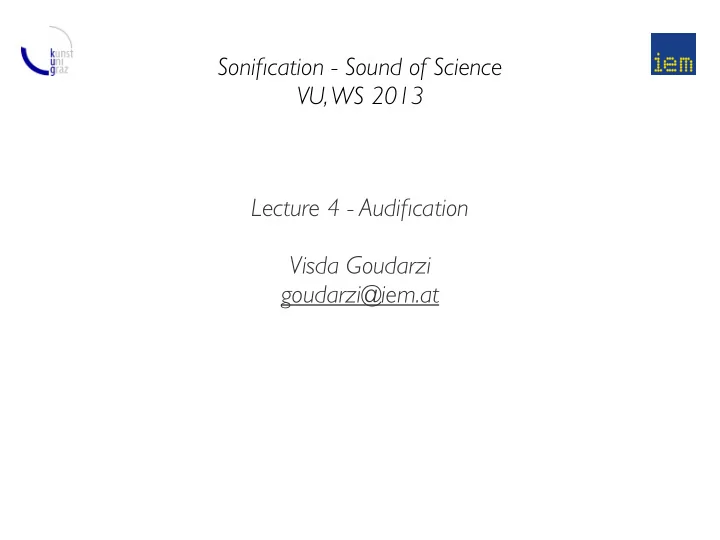

Sonification - Sound of Science VU, WS 2013 Lecture 4 - Audification Visda Goudarzi goudarzi@iem.at
Definition of Audification The direct playback of data samples. [Krammer, 1992] Audification is a technique of making sense of data by interpreting any kind of [a] signal as amplitude over time and playing it back on a loudspeaker for the purpose of listening. [Dombois, Eckel, 2011] Sonification - Sound of Science VU, WS 2013
Data for Audification • Sound recorded data (amplified, time stretched or compressed,...) e.g ultrasonic bat calls inaudible -> transposed • Acoustical data (elastomechanics, same physics laws as acoustic waves) e.g. stethoscope, seismographs with acceleration factors of 2,000 and more. • Physical data (difference velocities compared to acousticly familiar ones) e.g. EEG • Abstract data e.g. fax machine, stock data Sonification - Sound of Science VU, WS 2013
Example • dark side of the cell (clear pitched sounds from observing the motion of unpertubed Saccharomyces cerevisiae (baker's yeast). ) h"p://darksideofcell.info/composi4on.html Sonification - Sound of Science VU, WS 2013
Historical Overview (1800 - 1950) • 1819 - Stethoskop (laënnec) • 1876 - Telephone (Bell) • 1877 - Phonograph (Edison) • 1895 - Radiotelegraphy (Marconi) • 1908 - Geiger counter • 1924 - first Audification of bat calls • WW1- SONAR (Sound Navigation and ranging, idea from da Vinci) • 1942 - Vocoder Sonification - Sound of Science VU, WS 2013
Audification Process 1. Data Aquisition (sensor data, noise and distortion in data, quantization of sample values -> adds quantization noise to signal -> SNR (signal-to-noise ration), aliasing and clipping, ...) 2. Signal Conditioning (e.g. time axis manipulation depending on what the user is looking for e.g. temporal segmentation, coping with artifacts e.g. keeping or removing noisy data before analysis) 3. Sound Projection (e.g. multichannel) The Overall Audification Design depends on: The characteristics of the auditory system • The characteristics of the data set • The questions that drive the analysis • Sonification - Sound of Science VU, WS 2013
Characteristics of Human Auditory System Frequency Range: 20 Hz - 20k Hz (practical only 40 Hz - 10 kHz) • Frequency Resolution: 4Hz in the middle range ( 1-2 lHz) • Temporal Resolution: 20 - 50 ms • Dynamics Range: 120 dB at middle frequency (~1 kHz) • Masking Effects: simultaneous masking, temporal masking (e.g. time • axis manipulation to avoid it) Sonification - Sound of Science VU, WS 2013
The Signal Conditioning Stage The best conditioning is no conditioning • Re-sampling : Nyquist - Shannon sampling Theorem: f sampling > 2 f max • Filtering is mostly harmless • Compress only if there’s no other way • Special tools for special cases: • times reverse • noise reduction • frequency shifter • reverb • phase vocoder • Sonification - Sound of Science VU, WS 2013
Audification Play back at a standard audio sampling rate: 44100 Hz • When there are fewer values to play per second -> loop or • interpolate Sonification - Sound of Science VU, WS 2013
Example: EEG Sampling rate: 44100 Hz • Data points : d = 250 • Length of Audification: t = 250/44100 = 5.7 [ms] -> 24h data in • less than 10 mins Compression factor: c = 44100/d = 176.4 • Good for quality control, looking for events • Transposition = log 2 (c) = 7.5 [octaves] • Alpha waves as an interesting phenomenon : • 8 -13 Hz -> 1411 -2293 Hz (good hearable) Sonification - Sound of Science VU, WS 2013
Dataset: Weather in Feldbach h"p://www.wegenernet.org ¡ Sonification - Sound of Science VU, WS 2013
Dataset Feldbach (Reference Station 77) Air Temperature and Surface Temperature hourly each time for a whole year: Nov. 2007 - Oct. 2008: Feldbach_11_2007-11_2008.txt Nov. 2011 - Oct. 2012: Feldbach_11_2011-11_2012.txt Sonification - Sound of Science VU, WS 2013
Visualization Sonification - Sound of Science VU, WS 2013
Intro to SuperCollider Boot the Server • Initialize a Dictionary (e.g. “q”) for global variables • Reading DATA • Define path • test: File.exists (path)? • Use a FileReader • Read the more interesting columns using collect • Plot Data • Sonification - Sound of Science VU, WS 2013
Assignment II: Audification due Monday 28.10.13, 11:59:59 pm. Load the Data in multiple buffers using buffer.loadCollection • Load a SynthDef to audify the data • Play each synth and compare what you hear • How long does it take to play the whole file? • Which phenomenon can you hear and how can you adjust the • sampling rate to hear it more? Compare Air Temperature and Surface Temperature with your • audification. Compare the two different year of data with your audification and • analyze your results. Sonification - Sound of Science VU, WS 2013
Events Thomas Gorbach lecture on Acousmatics : 8.11.2013 11.00AM • Open CUBE : Installation of Sonification final projects: March 18th. • Open CUBE concert KULORK: May 20th. • Sonification - Sound of Science VU, WS 2013
Recommend
More recommend